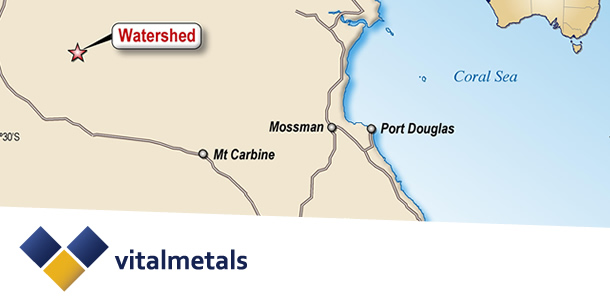
Capitalised at just $13 million, Vital is developing its Watershed mine, located 130 kilometres north-west of Cairns, which is projected to be capable of processing 2.5 million tonnes of ore a year, to produce up to 6,000 tonnes of tungsten concentrate a year, over an expected lifespan of ten years, with significant potential to extend that mine-life by exploration.
Australia has virtually the full suite of minerals, but tungsten is one of the missing items on the nation’s current menu. A century ago, Australia was the number one producer of tungsten in the world, but we have not had an operating mine since the Dolphin mine on Tasmania’s King Island was closed in 1990.
Tungsten has the highest melting point of any metal. The soft, grey metal undergoes a transformation when it is alloyed with steel to form very tough metals that are stable at high temperatures, and are used in critical temperature-sensitive, wear-resistant and corrosion-resistant machinery.
In its tungsten carbide form, tungsten is the second-hardest known substance, behind diamond. Tungsten-steel alloys are used to make such things as high-speed cutting tools, drilling bits, mining and manufacturing machinery, high-tech aviation materials, rocket engine nozzles and armaments, and the metal is also used on heat-resistant lubricants and fluorescent light bulbs, and even in golf clubs.
China dominates the global tungsten market in terms of both supply and demand, producing about 86% of the world’s supply, and consuming 60%. China imports more tungsten than the rest of the world combined. There is no viable substitute for tungsten: China treats it as a strategic metal, banning concentrate exports and restricting exports of ammonium paratungstate (APT). Tungsten is also classed as a strategic metal by the US government: the European Commission categorises it as a “critical raw material,” while the British Geological Survey ranks tungsten top of its metals “Risk List.”
With the exception of the re-opening of the Cantung mine in Canada’s Northwest Territories in October 2010, there has been only very limited additions to world supply for quite some time, and the market is in deficit, as demand from new users in India, China and other developing nations ramps up. That is a big problem for users of the metal, particularly Japan, which accounts for about 10% of world usage, but relies wholly on China for supply. Geo-politics and historical relationships being what they are, the Japanese are very keen to establish new sources of supply.
This is where Vital Metals (VML) comes in. Capitalised at just $13 million, Vital is developing its Watershed mine, located 130 kilometres north-west of Cairns, which is projected to be capable of processing 2.5 million tonnes of ore a year, to produce up to 6,000 tonnes of tungsten concentrate a year, over an expected lifespan of ten years, with significant potential to extend that mine-life by exploration. Production is expected to start in 2016.
Japanese interest in alternative tungsten supply is starkly demonstrated by Vital’s partner in Watershed, the Japanese Oil, Gas and Metals National Corporation (JOGMEC), which has earned a 30% interest in Watershed through stumping up $5.4 million to fund the definitive feasibility study (DFS), completed last year. JOGMEC is also working to source potential off-take/funding/development partners – most likely Japanese – to take the project through to production.
The Watershed tungsten deposit was discovered and explored by Utah Development Company in the early 1980s, with limited further work conducted by Peko-Wallsend in the mid-1980s. Vital bought the project in 2005 and has been developing the deposit since then.
It is a big deposit: Vital says Watershed ranks among the ten largest unexploited non-Chinese tungsten deposits worldwide. The resource is currently estimated at 49.2 million tonnes of scheelite ore at 0.14% WO3 (tungsten trioxide), for 70,400 tonnes WO3. The definitive feasibility study (DFS) put the reserve at 21.3 million tonnes of ore grading 0.15% WO3 (31,400 tonnes of contained WO3), over a mine life of ten years, at throughput of 2.5 million tonnes of ore a year, with about 40% of the resource extracted.
The mine will be open-pit, meaning cheaper costs – although with the resource open at depth and along strike, the company says there should be great opportunities to extend the life of Watershed through future underground or satellite open-pit operations.
Vital says market forecasters predict tungsten supply to decrease by about 3% a year over 2015–2017, while demand grows at 6% a year. Tungsten is not a traded metal on the commodities exchanges: metal producers usually strike their own deals with suppliers. Moving into a shortfall of supply, Vital says metal producers that fail to secure their raw-material supplies are running “considerable strategic risk.” From price levels around US$480 a metric tonne unit (mtu) of APT, Tungsten Market Research estimates that the price could go as high as $US650 a mtu of APT by 2019.
Watershed is expected to produce high-grade 65% WO3 ‘clean’ concentrate, of a kind that currently sells for about US$32,000 a tonne. At 2.5 million tonnes a year for ten years, Vital estimates that Watershed could earn $526 million from revenue of $1.08 billion. Given a lower Australian dollar falls and Australian mining costs, the project returns could be expected to increase.
The company says it has a “clear pathway” to commence the project in 2015. The main thing the share market will want to see is the signing of an off-take partner to help take Watershed through to production, which would result in a significant re-rating of the stock. Research firm Breakaway Research values Vital Metals at 16 cents a share – more than four times its current share price of 3.9 cents. Vital also has a gold exploration project in the West African nation of Burkina Faso, but that is an afterthought at present – tungsten and its positive market fundamentals are the big attraction in Vital Metals.







